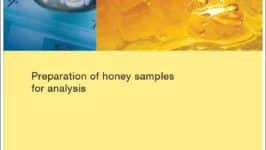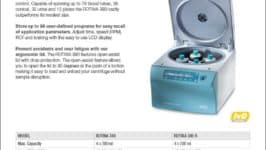Honey Sample Preparation Application Note
This application note provides information on specific application methods and the use of Hettich products. (more…) read more...
File size: 270.9 kb
Honey is a natural product that is a pure food source that is good for our health. However, the widespread use of crop protection agents, antibiotics, and other such products means that honey may contain substances that have an adverse impact on its quality or that can even be a potential health risk for humans. Honey is, therefore, subject to a wide range of analyses for quality assurance purposes and to protect consumers.
Despite the large number of parameters included in the analyses, the initial treatment of the honey is generally the same: The honey samples are taken from their containers and divided into aliquots. Extraction is then carried out, and the honey sample extracts are sent for analysis.
Hettich centrifuges can be used during the extraction procedure. A solvent is added to the sample, and the substance to be detected enters the solvent. Then, it is separated from the other constituents of the sample through the centrifugation procedure. The supernatant is removed and analyzed using a pipette.
ADVANTAGES OF THE HETTICH METHOD
1) Combining centrifugation and freezing in a single step saves time and labor
The freezing process results in the sediment being fully or partially frozen so that the supernatant can be more easily removed, and in particular quantitatively. Until now, it was necessary to freeze the sample after the centrifugation step. The coupled high-performance cooling unit and state-of-the-art control of the ROTINA 380 R centrifuge enable centrifugation and freezing to be carried out as a single step at reduced speed. Depending on the approach, the sediment can be fully frozen, and the supernatant derived quantitatively through simple decanting.
2) Space is saved as well since there is no need to store the samples in a freezer
3) Greater accuracy of the results
The results are more accurate since we have eliminated the difficult-to-reproduce step of removing the supernatant with a pipette.
PREPARATION
1) Preparation of the sample
1 ml of the honey sample is mixed with 1 ml of tap water at room temperature. 5 ml acetonitrile is then added, and mixing is repeated.
Important: The tubes must be closed, and the safety instructions followed for the handling of acetonitrile!
2) Centrifugation
Program 1 (pre-cooling)
The pre-cooling program PREC (Program number 99) is used to cool the centrifuge to -20 °C before use.
Program 2 (sedimentation)
The samples are then centrifuged for 5 minutes at 2,540 x g (corresponding to 4,000 min-1 with angle rotor No. 1721) at -20 °C.
Program 3 (phase separation)
Program 2 is followed automatically by program 3. In this program, the samples are centrifuged for a further 45 minutes at 1,000 min-1 at a temperature of -20 °C. The start-up and braking ramp are set to the highest value of 9.
Hettich products are designed to help you achieve optimal results for your application and are built to perform to the specifications outlined in the operators manual. For application-specific information and settings, please refer to your organization’s standard operating procedure. As always, our Hettich representatives are here to help determine which Hettich products and accessories best fit your laboratory requirements.

This application note provides information on specific application methods and the use of Hettich products. (more…) read more...

This product sheets provides a comprehensive overview of the unique product features specific to the model. (more…) read more...
Hettich manufactures centrifuges for any standard laboratory application.